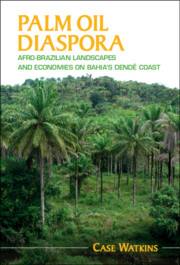16 results
5 - South Atlantic Exchange
-
- Book:
- Palm Oil Diaspora
- Published online:
- 20 May 2021
- Print publication:
- 20 May 2021, pp 136-181
-
- Chapter
- Export citation
Preface and Acknowledgments
-
- Book:
- Palm Oil Diaspora
- Published online:
- 20 May 2021
- Print publication:
- 20 May 2021, pp xiii-xx
-
- Chapter
- Export citation
Index
-
- Book:
- Palm Oil Diaspora
- Published online:
- 20 May 2021
- Print publication:
- 20 May 2021, pp 337-348
-
- Chapter
- Export citation
Epilogue
-
- Book:
- Palm Oil Diaspora
- Published online:
- 20 May 2021
- Print publication:
- 20 May 2021, pp 260-284
-
- Chapter
- Export citation
3 - Creolization
-
- Book:
- Palm Oil Diaspora
- Published online:
- 20 May 2021
- Print publication:
- 20 May 2021, pp 73-96
-
- Chapter
- Export citation
1 - Assembling an Afro-Brazilian Economy
-
- Book:
- Palm Oil Diaspora
- Published online:
- 20 May 2021
- Print publication:
- 20 May 2021, pp 1-47
-
- Chapter
- Export citation
4 - An Afro-Brazilian Landscape
-
- Book:
- Palm Oil Diaspora
- Published online:
- 20 May 2021
- Print publication:
- 20 May 2021, pp 97-135
-
- Chapter
- Export citation
Tables
-
- Book:
- Palm Oil Diaspora
- Published online:
- 20 May 2021
- Print publication:
- 20 May 2021, pp xi-xii
-
- Chapter
- Export citation
Contents
-
- Book:
- Palm Oil Diaspora
- Published online:
- 20 May 2021
- Print publication:
- 20 May 2021, pp v-vi
-
- Chapter
- Export citation
Figures
-
- Book:
- Palm Oil Diaspora
- Published online:
- 20 May 2021
- Print publication:
- 20 May 2021, pp vii-x
-
- Chapter
- Export citation
7 - Complexity
-
- Book:
- Palm Oil Diaspora
- Published online:
- 20 May 2021
- Print publication:
- 20 May 2021, pp 218-259
-
- Chapter
- Export citation
Bibliography
-
- Book:
- Palm Oil Diaspora
- Published online:
- 20 May 2021
- Print publication:
- 20 May 2021, pp 285-336
-
- Chapter
- Export citation
2 - African and Atlantic Worlds
-
- Book:
- Palm Oil Diaspora
- Published online:
- 20 May 2021
- Print publication:
- 20 May 2021, pp 48-72
-
- Chapter
- Export citation
Copyright page
-
- Book:
- Palm Oil Diaspora
- Published online:
- 20 May 2021
- Print publication:
- 20 May 2021, pp iv-iv
-
- Chapter
- Export citation
6 - Landscapes, Religions, Transitions
-
- Book:
- Palm Oil Diaspora
- Published online:
- 20 May 2021
- Print publication:
- 20 May 2021, pp 182-217
-
- Chapter
- Export citation

Palm Oil Diaspora
- Afro-Brazilian Landscapes and Economies on Bahia's Dendê Coast
-
- Published online:
- 20 May 2021
- Print publication:
- 20 May 2021



